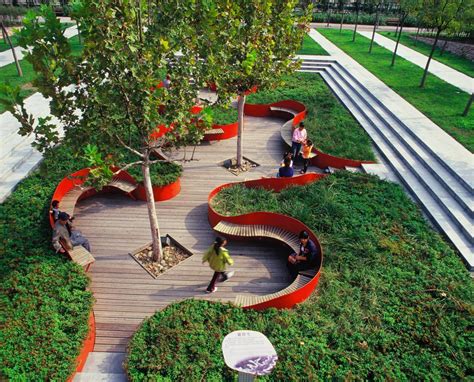In our modern urban landscape, green spaces have become a vital aspect of sustainable living and community well-being. From providing a natural haven for flora and fauna to offering a peaceful retreat for bustling city dwellers, the benefits of green spaces are undeniable. However, creating and maintaining a sustainable green space requires thoughtful planning and understanding of landscape design principles. In this blog post, we will delve into the world of landscape design and explore the journey of building green spaces. From the basics of landscape design to choosing the right plants and implementing sustainable landscaping techniques, we will cover it all. Join us as we uncover the impact of green spaces on well-being and the environment, and learn how to transform unused spaces into vibrant green oases. Whether you are an avid gardener or simply passionate about sustainable living, this blog post is for you. Get ready to embark on a journey into the world of landscape design and discover the art of creating welcoming and sustainable green spaces.
Table of Contents
The Benefits of Building Green Spaces
Building green spaces in urban areas has numerous benefits for both the environment and the people who live there. One of the most significant advantages is the improvement of air quality. Plants and trees in green spaces can help to filter out pollutants and provide fresh oxygen, leading to cleaner and healthier air for the community. Not only that, but green spaces also act as natural cooling systems, reducing the urban heat island effect and lowering temperatures in the surrounding areas.
Another benefit of green spaces is the positive impact on mental health and well-being. Research has shown that spending time in natural environments can reduce stress, anxiety, and depression, as well as improve overall mood and cognitive function. Creating green spaces within urban landscapes provides residents with access to nature, increasing opportunities for relaxation, exercise, and social interaction.
In addition to the environmental and psychological benefits, building green spaces can also have economic advantages. Properties located near green spaces often experience increased value, as the presence of natural amenities is desirable to potential buyers and renters. Furthermore, green spaces can contribute to cost savings for the community by mitigating stormwater runoff, reducing the need for costly infrastructure and flood control measures.
Overall, the benefits of building green spaces are far-reaching, impacting the environment, public health, and the local economy. By incorporating green spaces into urban planning and development, communities can create more sustainable, vibrant, and resilient places to live, work, and play.
Understanding the Basics of Landscape Design
When it comes to landscape design, there are a few key basics that every homeowner or property owner should understand. First and foremost, it’s important to have a clear understanding of the available space that you have to work with. This means taking accurate measurements and considering any existing structures, pathways, or natural features that should be incorporated into the design.
Once you have a clear understanding of your space, it’s important to establish a clear vision for the overall design of your landscape. This can include deciding on a specific theme, color scheme, or style that you want to incorporate into the space. Having a clear vision will help guide the rest of the design process.
Another important aspect of landscape design is functionality. It’s essential to consider how the space will be used and what elements are necessary to make it both practical and visually appealing. This can include things like seating areas, pathways, and specific plantings to create different zones within the space.
Finally, it’s crucial to think about the long-term maintenance of your landscape design. This includes choosing the right plants for your climate and soil conditions, as well as considering sustainable landscaping techniques to ensure that your green space remains healthy and vibrant for years to come.
Planning a Sustainable Green Space: Input
When planning a sustainable green space, it is important to consider the input involved in the process. This includes gathering information about the area, setting goals for the space, and understanding the needs of the community.
One of the first steps in planning a sustainable green space is to assess the area where the space will be developed. This may involve conducting a site analysis to understand the environmental conditions, such as soil types, sunlight exposure, and water availability. By gathering this information, designers can make informed decisions about the types of plants and materials to use in the space.
Another important input in the planning process is setting clear goals for the green space. This may involve determining the purpose of the space, whether it be for recreation, education, or environmental conservation. By clearly defining the goals of the space, designers can ensure that the final design meets the needs of the community and the environment.
Understanding the needs of the community is also crucial in planning a sustainable green space. This may involve conducting surveys or community meetings to gather input from residents about the types of amenities they would like to see in the space. By incorporating the input of the community, designers can create a green space that is truly sustainable and meets the needs of its users.
Designing a Green Space: Development
When designing a green space, the development phase is crucial in bringing the concept to life. This involves turning the plans and ideas into a tangible and functional area that promotes environmental sustainability and enhances the surrounding community.
During the development stage, landscape architects and designers work on refining the details of the green space. They consider factors such as the terrain, drainage, and irrigation systems to ensure that the space is not only visually appealing but also practical and efficient in its use of resources.
Furthermore, the development phase involves the selection and placement of hardscape elements such as pathways, seating areas, and focal points within the green space. These elements are strategically integrated to create a cohesive and inviting environment that encourages people to interact with nature.
Additionally, the development of a green space may also involve the installation of sustainable features such as rain gardens, green roofs, or permeable paving to mitigate stormwater runoff and promote biodiversity within the area.
Choosing the Right Plants for Your Green Space
When it comes to designing a green space, one of the most important aspects to consider is the type of plants you choose to incorporate. The right plants can not only enhance the aesthetic appeal of your green space but also play a crucial role in its overall sustainability and environmental impact.
Before selecting the plants for your green space, it’s essential to assess the environmental conditions of the area, including sunlight exposure, soil type, and climate. Understanding these factors will help you select plants that are well-suited to thrive in the specific conditions of your green space.
Another key consideration when choosing plants for your green space is their water and maintenance requirements. Opting for drought-resistant plants and native species can help minimize the need for excessive watering and maintenance, making your green space more sustainable and cost-effective in the long run.
Additionally, incorporating a diverse range of plants in terms of size, shape, and blooming seasons can contribute to a thriving and visually appealing green space. This approach can also support local biodiversity and provide habitat for wildlife, further enhancing the ecological benefits of your green space.
Implementing Sustainable Landscaping Techniques
When it comes to creating a green space, it’s important to prioritize sustainability by implementing sustainable landscaping techniques. These techniques focus on minimizing the negative impact on the environment while maximizing the benefits of the space.
One sustainable landscaping technique is the use of native plants. Native plants are well-adapted to the local climate and require less water, fertilizer, and pesticides compared to non-native species. By incorporating native plants into your green space, you can promote biodiversity and reduce maintenance needs.
Another key technique is the utilization of permeable paving materials. Permeable pavers allow rainwater to infiltrate the soil, reducing stormwater runoff and preventing erosion. This helps to maintain the natural hydrological cycle and minimizes the burden on municipal stormwater systems.
Additionally, implementing efficient irrigation systems, such as drip irrigation or smart controllers, can help conserve water and minimize waste. By delivering water directly to the root zones of plants, these systems reduce water loss through evaporation and runoff, leading to healthier and more sustainable landscapes.
Maintaining and Caring for Your Green Space
Once you have designed and implemented a green space, it is important to maintain and care for it properly to ensure its longevity and continued beauty. Proper maintenance can prevent issues such as overgrowth, pest infestation, and drainage problems, keeping your green space looking its best.
Regular maintenance tasks for your green space may include mowing the lawn, pruning trees and shrubs, weeding flower beds, and monitoring irrigation systems. These tasks not only help to keep your green space looking neat and tidy, but also contribute to the health and wellbeing of the plants and overall ecosystem.
In addition to regular maintenance, it is important to care for your green space by using sustainable practices. This may include choosing eco-friendly fertilizers and pest control methods, using native plants that require less water and maintenance, and reducing the use of chemical pesticides and herbicides. By implementing sustainable practices, you can create a green space that is not only beautiful, but also environmentally friendly and beneficial for local wildlife.
By maintaining and caring for your green space, you can enjoy the benefits of a thriving, sustainable landscape that enhances the beauty of your property and contributes to the health of the environment.
Creating a Welcoming Landscape Design: Input
When brainstorming ideas for creating a welcoming landscape design, it’s essential to consider the input of the homeowners or the individuals who will be interacting with the space on a regular basis. Understanding their preferences, needs, and vision for the green space is crucial in developing a design that truly reflects their desires. This input could range from the types of plants and flowers they want to see, to the overall layout and functionality of the space.
Additionally, input from a professional landscape designer or architect can also be invaluable in creating a welcoming landscape design. Their expertise and knowledge can help translate the homeowners’ ideas into a well-executed plan, ensuring that the green space is not only aesthetically pleasing but also functional and sustainable. Collaboration between the homeowners and the design professionals is key in creating a cohesive and harmonious landscape design.
It’s also important to take into consideration the environmental input when creating a welcoming landscape design. Choosing native plants, implementing sustainable landscaping techniques, and utilizing eco-friendly materials are all crucial aspects of developing a green space that not only looks beautiful but also benefits the environment. Considering the environmental impact of the design is a key input that can ultimately enhance the overall appeal of the landscape.
Overall, creating a welcoming landscape design requires input from multiple stakeholders, including the homeowners, design professionals, and the environment. By integrating these various inputs, a well-thought-out and cohesive green space can be created, providing a welcoming and inviting outdoor environment for all to enjoy.
Transforming Unused Spaces into Green Oases
Transforming unused spaces into green oases can have a significant impact on both the environment and the well-being of the community. By taking neglected or underutilized areas and turning them into vibrant, sustainable green spaces, we can create havens that promote biodiversity, improve air and water quality, and provide tranquil retreats for people to enjoy.
When identifying potential areas for transformation, it’s important to consider the needs and desires of the local community. This could involve surveying residents to understand what they would value in a green space, whether it be a place for exercise, relaxation, or community activities. By incorporating input from the community, the green oases can be designed to truly meet the needs of those who will benefit from them.
Developing these spaces requires careful planning and attention to detail. From selecting the right plants and materials to implementing sustainable landscaping techniques, every decision should be informed by the goal of creating a thriving, environmentally friendly space. By choosing native plants, incorporating rain gardens, and using permeable paving, the green oases can help manage stormwater, reduce heat islands, and support local wildlife.
As these spaces come to life, they will require ongoing care and maintenance to ensure they continue to flourish. This may involve establishing volunteer groups or working with local organizations to keep the green oases clean and healthy. With dedication and community involvement, these revitalized spaces can become valuable assets that enhance the well-being of everyone who interacts with them.
The Impact of Green Spaces on Well-being and Environment
Green spaces, such as parks, gardens, and other natural areas, have a significant impact on both the well-being of individuals and the environment. These areas provide a much-needed escape from the hustle and bustle of city life, allowing people to connect with nature and reap the benefits of spending time outdoors. Research has shown that spending time in green spaces can reduce stress, anxiety, and depression, leading to improved mental health and overall well-being.
Furthermore, green spaces play a crucial role in supporting environmental health. They serve as habitats for various plant and animal species, contributing to biodiversity and ecological balance. In addition, green spaces help mitigate the impacts of climate change by absorbing carbon dioxide and releasing oxygen, thereby improving air quality. They also have a cooling effect on urban areas, reducing the heat island effect and energy consumption.
Investing in and maintaining green spaces is essential for creating healthier and more resilient communities. By prioritizing the development and preservation of these areas, we can promote both human well-being and environmental sustainability. Whether through urban planning, landscaping efforts, or community initiatives, the impact of green spaces on well-being and the environment cannot be overstated.
In conclusion, the presence of green spaces has far-reaching effects on both individual well-being and the overall health of the environment. By recognizing and understanding the value of these spaces, we can work towards creating healthier, more vibrant communities while also safeguarding the natural world around us.






